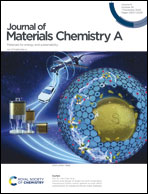Vanadium oxynitrides as stable catalysts for electrochemical reduction of nitrogen to ammonia: the role of oxygen†
Abstract
Electrochemical reduction of nitrogen to ammonia can potentially replace the existing centralized fossil fuel-based Haber–Bosch process with small, decentralized units relying on electrical energy from renewable sources, thus supporting a sustainable food and energy infrastructure. Recent activities in the development of transition metal nitride electrocatalysts for this reaction have shown promise, but oxynitrides remain unexplored. We have performed a rigorous computational study of the highly promising vanadium oxynitride (VON) to establish for the first time the nitrogen reduction pathway in oxynitrides and the role of the mixed anions that can lead to improved stability of the active surface-states, activity, and selectivity over hydrogen evolution. The electrocatalytic properties are best enhanced at low oxygen content (12.5%) due to optimal balance between consecutive protonation preference at N-sites over V-sites, low onset potential (0.4 V-RHE), and facile N2 adsorption at N-vacancy sites, while a higher oxygen containing VON (31.25%) shows the lowest N2 adsorption/dissociation barrier (∼0.3 eV) on the anion vacancy and can also be a potential N2RR catalyst with a higher NH3 turn over frequency, albeit with a lower stability and higher overpotential (0.6 V-RHE) compared to x = 12.5%. The critical N-vacancy active sites are protected from self-annihilation by the mixed-valency anions, large kinetic barriers, and site blocking by O*/OH*/H* due to highly favorable N2 absorption.



 Please wait while we load your content...
Please wait while we load your content...